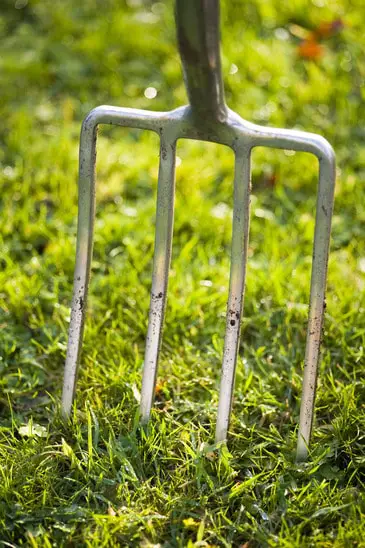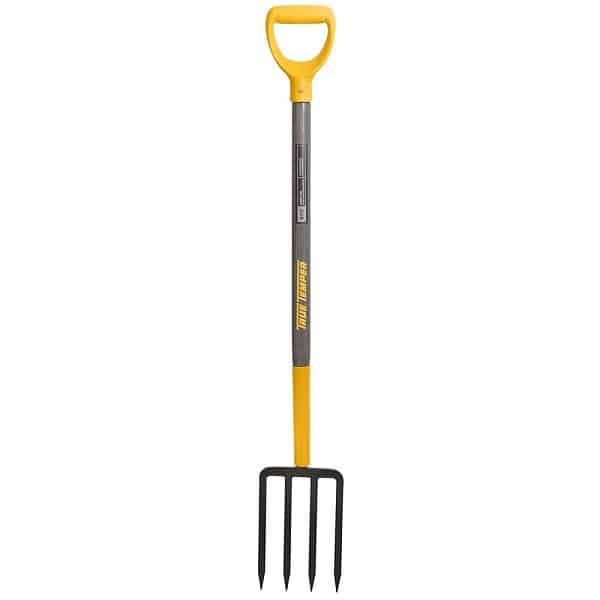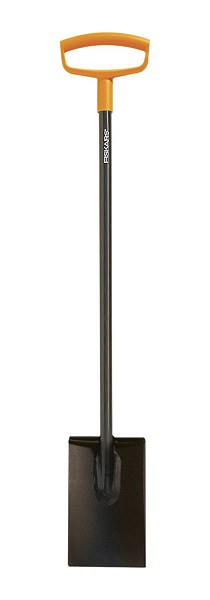The 5 Best Garden Forks for Homeowners and their Gardens

Garden forks are an underrated basic garden tool that can do many jobs easier than a shovel
Quick Navigation
THERE ARE MANY DIFFERENT types of out there vying to be the best garden fork. Many of which, look very similar. So how do you tell which one is right for you?
Not only are there standard garden forks, but there are also job specific ones. There is a fork for pulling out potatoes, spreading and moving hay, digging, and composting to name just a few. With so many different forks available (I will cover these later), let's concentrate on how to find the best garden fork for you to use in your home garden. If you're only starting a garden, you'll should get the right equipment to do it well.
How Do I Know Which Garden Fork I Need?
As with any tool purchase, there are questions you need to ask yourself before you rush out and buy a garden fork or order one online.

Garden forks are better than shovels and spades for moving mulch, compost, straw etc.
Q1 - Why are You Buying a Garden Fork?
What type of work are you planning to do? Do you need a heavy duty digging fork for clearing the land and preparing it for planting or do you just need one to keep the soil turned over?
Q2 - How Much Garden Space Do You Have?
The last thing you want when you have a lot of garden space to work with is a small fork that has you doing double the work to turn the soil over. You might also be able to get away with a less expensive fork if you don't need to use it as much
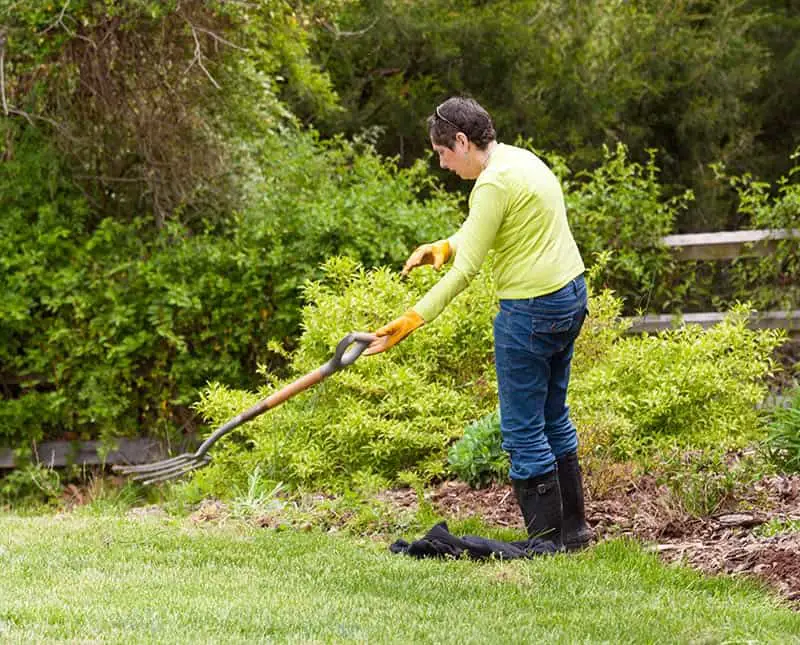
Using a garden fork for a long time can get tiresome
Q3 - Can You Handle the Weight?
The bigger the fork, the heavier it is likely to be. Choose a fork you will be able to use for what could be several hours at a time. While not exactly necessary, a cushioned handle might also be worth looking at. It really all depends on how many hours you plan to use your garden fork for in a given period of time.
What Makes a Good Garden Fork?
One of the first thoughts through most gardener's minds when looking at simple hand tools such as garden forks is to try and spend as little money as possible on them.
When it comes to most garden tools, including forks, the last thing you want to do is waste your money on a cheap fork that is going to bend or break the first time you use it. A good quality garden manual garden tool should last you a lifetime.
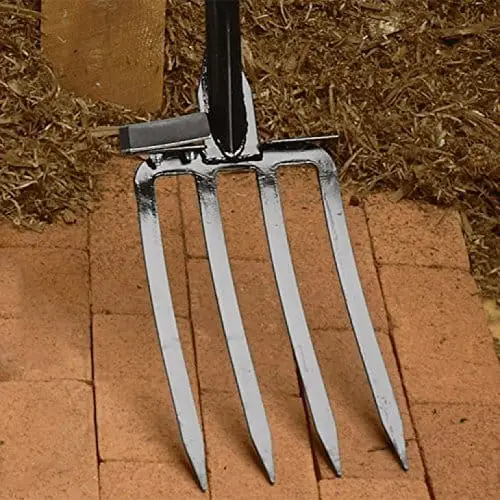
4 Tine Fork - Image courtesy of Amazon
The Tines and Head
The tines and head are perhaps the most important part of a good garden fork. For general purpose usage, your best bet is a digging fork with a forged steel head. The forged steel is not likely to bend or break under normal usage (all forks will bend if you overwork them).
Your best choice is a garden fork with a head and tines that have been forged from a single piece of high-carbon steel. There are a number of aluminum alloy forks on the market which are great for light-duty work. But, I would not recommend them for general purpose gardening work as they tend to bend easily, especially those with a high percentage of aluminum in the alloy.
Tine Shape
If you plan to use your garden fork for digging or turning the soil over, round tines are not going to get the job done. Your garden fork needs the ability to act like a spade or shovel to a certain extent.
Look for a garden fork that has flat-faced tines. These will make it much easier for you to lift and turn the soil, aerate it, mixing in manure or compost, and digging up root veggies or potatoes. However, if you plan to use your fork for harvesting potatoes or root crops a purpose-made fork with blunt tips is a better choice.
The most common garden fork has four tines, which is more than enough. Some digging forks have several more, but they are thinner and blunt on the end to be used for harvesting, not real digging.
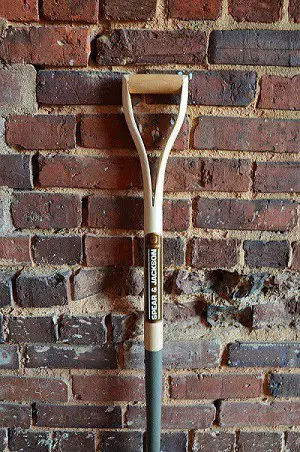
Gardening forn on a brick wall - Image courtesy of Amazon
Handle
The right handle can make all the difference in the world. While a long handle can reduce the amount of effort you need to expend, in most cases, it will simply get in the way. The standard 30-inch long handle is ideal for most applications.
Like most garden tools, you can choose a hardwood, fiberglass, or steel handle. Wood, typically a hardwood such as ash is your best choice. This type of handle has a little give in it, letting you work heavier loads or dig up compressed soil without breaking and it's not too heavy.
Most fiberglass handles are lightweight, which is good until you have some heavy digging to do. In this case, you might find they flex too much and may break or shatter. Fiberglass handles are okay for light duty work, but not recommended for heavier tasks.
Steel handles tend to be pretty heavy and prone to rust unless they are coated in some form of resin. The good thing is that it is almost impossible to break steel handles, the bad news is that forks with steel handles tend to be expensive.

Image courtesy of The Parenting Patch
Handle Shape
T or D shaped. Or maybe round or straight? Handle shape is more a matter of personal taste. Myself, I prefer a fork with a D-Handle because I find them easier to control and use. T-handles are okay but tend to break more easily and in my opinion, are harder to use. Keep in mind that the cheaper forks use cheap plastic for the handles that can easily break under heavy or continuous use.
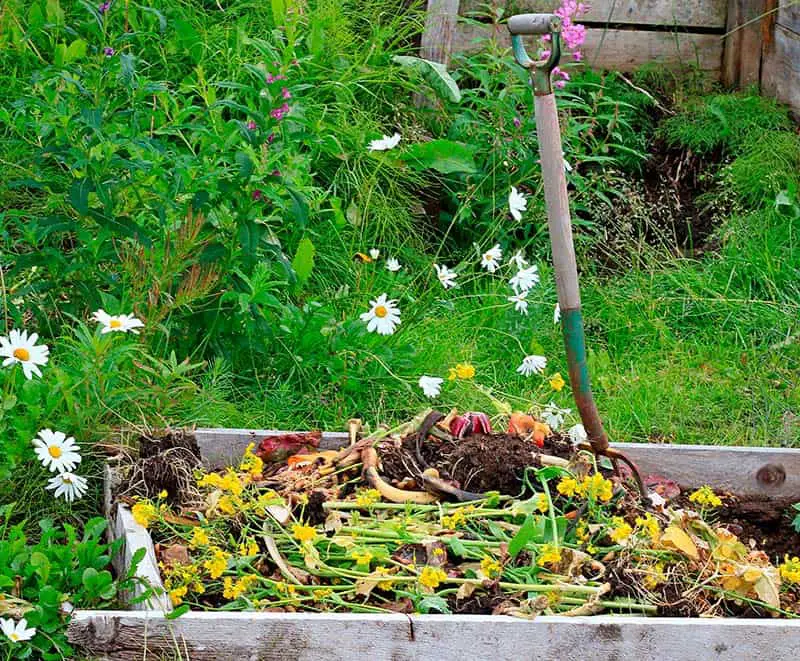
Although this fork has seen its fair share of compost, it works as well as the day it was bought
Construction / Assembly
There are several ways in which garden forks are assembled.
Many older wood-handled forks were made with the heat and insert method. This method involved heating the metal collar of the head until it was red-hot, inserting the handle into the sleeve, and then plunging it into cold water. This would instantly shrink the metal sealing it to the handle. Over time the handle can work loose.
A much better choice is to buy a garden fork that has the head riveted or bolted in place so that you can tighten it up as necessary (all of mine have bolts).
Fiberglass handles may be riveted, bolted, or even pressed into the collar with a locking ring. The riveted and bolted styles hold up well, but again the pressed in style tend to work loose over time.
When it comes to steel-handled forks, while some may be riveted or bolted together, many come as one single piece (head and handle) of forged steel. With this type of fork, you have to consider the weight versus how you plan to use it. The only thing you really have to worry about with a one-piece steel fork is whether or not you can bend the handle.
The 5 Picks for the Best Garden Fork
1. Radius Garden 203 PRO Ergonomic Stainless-Steel Digging Fork
The round handle is unique and very ergonomic
The Radius garden fork will strike you as different the moment you lay eyes on the "O" shaped handle. This revolutionary shape was chosen for its ability to reduce both hand and wrist stress. The material is non-slip and the handle is big enough for both hands (even big hands like mine). The stainless-steel head has four super-sharp tines that will penetrate even the most stubborn soil and the resin-encased steel shaft won't bend or break.
Pros | Cons |
|---|---|
Stainless-steel head with 4 sharp diamond shape tines | Tines are brittle and may break off |
Solid steel shaft for superior strength | Handle can take some getting used to |
O-shaped handle for added comfort | Less than stellar customer service |
2. Truper 30293 30-Inch 4 Tined Spading Fork
This "trooper" comes through in spades
Looking for a good garden fork that acts like a spade and comes with a solid ash handle? This one from Truper comes up roses. The D-grip is very comfortable and gives you much better control than you are likely to see in many other "digging" forks. The gray steel head features 4 tines and is clear coated for added protection. The tines are nice and sharp for those times when you need to dig through hard or compacted dirt.
Pros | Cons |
|---|---|
Comfortable D-Grip handle | Tines are brittle and may break |
Sharp points on tines help with tough jobs | Quality control issues |
Ash handle is made to last | Not for heavy duty use |
3. Fiskars 47 Inch Steel D-Handle Ergo Garden Fork
Not quite a pitchfork but it is pretty close
At 47 inches long this garden fork from Fiskars is not quite a pitchfork but it might as well be. If you are looking for a fork that is a little longer (I like this one because at 6'4" tall short forks give me a backache). It comes with a classic "D" style handle for maximum control and a welded boron steel head and shaft for durability. The handle has been angled to help reduce strain and fatigue. While the tines are pointed, they are not as sharp as some brands, which slows down the process of digging compacted soil.
Pros | Cons |
|---|---|
Welded boron steel head and shaft | Tines could be sharper |
Extra-long handle | Hollow shaft feels weak |
Angle D-grip for comfort and ergonomics | Tines bend under heavy usage |
4. True Temper Forged Spading Fork With 4 Tines
Long tines with sharp points penetrate with ease
Made by Ames, this garden fork is made with a forged steel head that has four long tines with sharp points. The broad tines make turning over soil a breeze while the sharp points ensure you can sink this fork into the hardest ground with ease. The head is made from long-lasting diamond steel. Comes with a 30-inch hardwood handle for less flex and more control. The bright yellow poly "D" handle offers superior control.
Pros | Cons |
|---|---|
4 Diamond steel tines | Poly handle has too much flex |
Hardwood handle | Narrow area for foot |
Poly D handle for better control | Tines are thin and subject to bending |
5. Spear & Jackson R712 Traditional English Style Stainless Steel Digging Fork
Made in England – built from stainless steel to last
The Spear & Jackson Company has been building superior quality garden tools in Sheffield, England since 1766 and still uses the same traditional craftsmanship they have been using for over 250 years. This is a traditional English style digging fork with a polished steel head that features four long sharp tines. The hardwood handle is double riveted onto the hardwood handle. The shaft is split at the top to form the wishbone handle and the whole thing is sealed against the elements.
Pros | Cons |
|---|---|
One-piece hardwood shaft | Handle may break where it goes into fork head |
Polished steel tines for rust-resistance | Steel not made in England |
Lightweight and easy to use | Steel will rust |
Think a Garden Spade Might Be Better?
Not everyone wants to use a garden fork to dig their gardens. Some people prefer to use a spade to dig in a new garden or turn over the soil in their existing one. To be honest, I have a couple of different spades in the shed I use for certain jobs.
Fiskars 46 Inch Steel D-handle Square Garden Spade
Square blade is perfect for cutting in new gardens
This square garden spade is perfect for cutting your garden in, edging, cutting through turf, turning over soil and more. It features and extra-large "D" handle for big hands and better control. The 18-gauge steel shaft and 14-gauge blade are hardened for maximum strength and durability. The shaft won't flex like a fiberglass one and the blade is sharp enough to cut through sod and soil easily.
Pros | Cons |
|---|---|
Hardened steel shaft and blade | Handle is only attached with a single screw |
Extra-large "D" handle | Blade is too flexible |
Nice sharp blade | Blade prone to rust |
Down to the Last Fork Full
With so many different brands and models to choose from, picking the best garden forks is not an easy task. As for me, I chose the Radius Garden Pro for my main garden fork. Now that I have finally gotten used to the "O" shaped handle, I love it. I have yet to break or bend any of the tines and have been using it for a couple of years.
One last thought, go out to your local discount home DIY store and try a few to see what type of handle you like, how long you need the handle to be, and of course which one feels best to you.
Thanks for reading my guide on finding the best garden fork for homeowners. Any comments or questions, please contact me here.
Related Articles:

